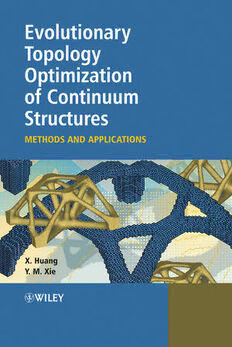Table Of ContentP1:OTE/OTE/SPH P2:OTE
FM JWBK445-Huang January25,2010 18:3 PrinterName:YettoCome
EVOLUTIONARY
TOPOLOGY
OPTIMIZATION OF
CONTINUUM
STRUCTURES
Evolutionary Topology Optimization of Continuum Structures: Methods and Applications X. Huang and Y.M. Xie
© 2010 John Wiley & Sons Ltd. ISBN: 978-0-470-74653-0
P1:OTE/OTE/SPH P2:OTE
FM JWBK445-Huang January25,2010 18:3 PrinterName:YettoCome
EVOLUTIONARY
TOPOLOGY
OPTIMIZATION OF
CONTINUUM
STRUCTURES
METHODS AND APPLICATIONS
X.Huang
SchoolofCivil,EnvironmentalandChemicalEngineering,
RMITUniversity,Australia
Y.M.Xie
SchoolofCivil,EnvironmentalandChemicalEngineering,
RMITUniversity,Australia
A John Wiley and Sons, Ltd., Publication
P1:OTE/OTE/SPH P2:OTE
FM JWBK445-Huang January25,2010 18:3 PrinterName:YettoCome
Thiseditionfirstpublished2010
(cid:1)C 2010,JohnWiley&Sons,Ltd
Registeredoffice
JohnWiley&SonsLtd,TheAtrium,SouthernGate,Chichester,WestSussex,PO198SQ,UnitedKingdom
Fordetailsofourglobaleditorialoffices,forcustomerservicesandforinformationabouthowtoapplyforpermissionto
reusethecopyrightmaterialinthisbookpleaseseeourwebsiteatwww.wiley.com.
TherightoftheauthortobeidentifiedastheauthorofthisworkhasbeenassertedinaccordancewiththeCopyright,
DesignsandPatentsAct1988.
Allrightsreserved.Nopartofthispublicationmaybereproduced,storedinaretrievalsystem,ortransmitted,inanyform
orbyanymeans,electronic,mechanical,photocopying,recordingorotherwise,exceptaspermittedbytheUKCopyright,
DesignsandPatentsAct1988,withoutthepriorpermissionofthepublisher.
Wileyalsopublishesitsbooksinavarietyofelectronicformats.Somecontentthatappearsinprintmaynotbeavailablein
electronicbooks.
Designationsusedbycompaniestodistinguishtheirproductsareoftenclaimedastrademarks.Allbrandnamesand
productnamesusedinthisbookaretradenames,servicemarks,trademarksorregisteredtrademarksoftheirrespective
owners.Thepublisherisnotassociatedwithanyproductorvendormentionedinthisbook.Thispublicationisdesignedto
provideaccurateandauthoritativeinformationinregardtothesubjectmattercovered.Itissoldontheunderstandingthat
thepublisherisnotengagedinrenderingprofessionalservices.Ifprofessionaladviceorotherexpertassistanceisrequired,
theservicesofacompetentprofessionalshouldbesought.
MATLAB(cid:1)RisatrademarkofTheMathWorks,Inc.andisusedwithpermission.TheMathWorksdoesnotwarrantthe
accuracyofthetextorexercisesinthisbook.Thisbook’suseordiscussionofMATLAB(cid:1)Rsoftwareorrelatedproductsdoes
notconstituteendorsementorsponsorshipbyTheMathWorksofaparticularpedagogicalapproachorparticularuseofthe
MATLAB(cid:1)Rsoftware.
LibraryofCongressCataloging-in-PublicationData
Huang,X.(Xiaodong),1972–
Evolutionarytopologyoptimizationofcontinuumstructures:methodsandapplications/byX.Huang,Y.M.Xie.
p.cm.
Includesbibliographicalreferencesandindex.
ISBN978-0-470-74653-0(cloth)
1.Structuraloptimization. 2.Topology. I.Xie,Y.M. II.Title.
TA658.8.H832010
624.1(cid:2)7713–dc22
2009049233
AcataloguerecordforthisbookisavailablefromtheBritishLibrary.
ISBN: 978-0-470-74653-0(Hbk)
Typesetin10/12ptTimesbyAptaraInc.,NewDelhi,India
PrintedintheUK
P1:OTE/OTE/SPH P2:OTE
FM JWBK445-Huang January25,2010 18:3 PrinterName:YettoCome
Contents
Preface xi
1 Introduction 1
1.1 StructuralOptimization 1
1.2 TopologyOptimizationofContinuumStructures 1
1.3 ESO/BESOandtheLayoutoftheBook 2
References 3
2 EvolutionaryStructuralOptimizationMethod 5
2.1 Introduction 5
2.2 ESOBasedonStressLevel 5
2.2.1 EvolutionaryProcedure 5
2.2.2 ExampleofTwo-barFrame 6
2.2.3 ExamplesofMichellTypeStructures 7
2.3 ESOforStiffnessorDisplacementOptimization 7
2.3.1 SensitivityNumberandEvolutionaryProcedure 7
2.3.2 ExampleofaShortCantilever 12
2.3.3 ExampleofaBeamStructure 12
2.4 Conclusion 14
References 15
3 Bi-directionalEvolutionaryStructuralOptimizationMethod 17
3.1 Introduction 17
3.2 ProblemStatementandSensitivityNumber 18
3.2.1 ProblemStatement 18
3.2.2 SensitivityNumber 19
3.3 FilterSchemeandImprovedSensitivityNumber 19
3.3.1 CheckerboardandMesh-dependencyProblems 19
3.3.2 FilterSchemeforBESOMethod 20
3.3.3 StabilizingtheEvolutionaryProcess 22
3.4 ElementRemoval/AdditionandConvergenceCriterion 22
3.5 BasicBESOProcedure 25
P1:OTE/OTE/SPH P2:OTE
FM JWBK445-Huang January25,2010 18:3 PrinterName:YettoCome
vi Contents
3.6 ExamplesofBESOStartingfromInitialFullDesign 25
3.6.1 TopologyOptimizationofaShortCantilever 25
3.6.2 TopologyOptimizationofaBeam 29
3.7 ExamplesofBESOStartingfromInitialGuessDesign 31
3.8 Exampleofa3DStructure 33
3.9 Mesh-independenceStudies 35
3.10 Conclusion 37
References 38
4 BESOUtilizingMaterialInterpolationSchemewithPenalization 39
4.1 Introduction 39
4.2 ProblemStatementandMaterialInterpolationScheme 40
4.2.1 ProblemStatement 40
4.2.2 MaterialInterpolationScheme 40
4.3 SensitivityAnalysisandSensitivityNumber 41
4.3.1 SensitivityAnalysis 41
4.3.2 SensitivityNumber 42
4.4 Examples 43
4.4.1 TopologyOptimizationofaShortCantilever 43
4.4.2 TopologyOptimizationofaBeam 45
4.4.3 TopologyOptimizationofa3DCantilever 45
4.5 Conclusion 47
Appendix4.1 47
References 50
5 ComparingBESOwithOtherTopologyOptimizationMethods 51
5.1 Introduction 51
5.2 TheSIMPMethod 52
5.3 ComparingBESOwithSIMP 53
5.3.1 ComparisonofTopologyOptimizationAlgorithmswithouta
Mesh-independencyFilter 54
5.3.2 ComparisonofTopologyOptimizationAlgorithmswitha
Mesh-independencyFilter 54
5.3.3 AdvantagesoftheBESOMethodandQuestionsyetto
beResolved 57
5.4 DiscussiononZhouandRozvany(2001)Example 59
5.4.1 IntroductionofZhouandRozvany(2001)Example 59
5.4.2 IsitaNonoptimaloraLocalOptimalSolution? 59
5.4.3 AvoidanceofHighlyInefficientLocalOptimum 61
5.5 Conclusion 61
References 62
6 BESOforExtendedTopologyOptimizationProblems 65
6.1 Introduction 65
6.2 MinimizingStructuralVolumewithaDisplacementor
ComplianceConstraint 66
P1:OTE/OTE/SPH P2:OTE
FM JWBK445-Huang January25,2010 18:3 PrinterName:YettoCome
Contents vii
6.2.1 SensitivityAnalysisandSensitivityNumber 66
6.2.2 DeterminationofStructuralVolume 67
6.2.3 Examples 68
6.3 StiffnessOptimizationwithanAdditionalDisplacementConstraint 69
6.3.1 SensitivityNumber 72
6.3.2 DeterminationofLagrangianMultiplier 73
6.3.3 Examples 73
6.4 StiffnessOptimizationofStructureswithMultipleMaterials 78
6.4.1 SensitivityNumber 78
6.4.2 Examples 79
6.5 TopologyOptimizationofPeriodicStructures 80
6.5.1 ProblemStatementandSensitivityNumber 83
6.5.2 Examples 84
6.6 TopologyOptimizationofStructureswithDesign-dependentGravity
Load 92
6.6.1 SensitivityAnalysisandSensitivityNumber 92
6.6.2 Examples 94
6.7 TopologyOptimizationforNaturalFrequency 99
6.7.1 FrequencyOptimizationProblemandMaterial
InterpolationScheme 100
6.7.2 SensitivityNumber 102
6.7.3 Examples 103
6.8 TopologyOptimizationforMultipleLoadCases 111
6.8.1 SensitivityNumber 111
6.8.2 Examples 112
6.9 BESOBasedonvonMisesStress 113
6.9.1 SensitivityNumber 115
6.9.2 Examples 116
6.10 Conclusion 119
References 119
7 TopologyOptimizationofNonlinearContinuumStructures 121
7.1 Introduction 121
7.2 ObjectiveFunctionsandNonlinearAnalysis 122
7.3 SensitivityAnalysisandSensitivityNumberforForceControl 124
7.4 SensitivityAnalysisandSensitivityNumberforDisplacement
Control 126
7.5 BESOProcedureforNonlinearStructures 127
7.6 ExamplesofNonlinearStructuresunderForceControl 128
7.6.1 GeometricallyNonlinearStructure 128
7.6.2 MateriallyNonlinearStructure 129
7.6.3 GeometricallyandMateriallyNonlinearStructures 131
7.6.4 EffectsoftheNonlinearPropertiesandtheMagnitudeof
theDesignLoad 132
7.6.5 Three-dimensionalGeometricallyandMaterially
NonlinearStructure 134
P1:OTE/OTE/SPH P2:OTE
FM JWBK445-Huang January25,2010 18:3 PrinterName:YettoCome
viii Contents
7.7 ExamplesofNonlinearStructuresunderDisplacementControl 136
7.7.1 ResultsfromaRelativelySmallDesignDisplacement 136
7.7.2 ResultsfromLargeDesignDisplacements 139
7.7.3 Exampleofa3DStructure 144
7.8 Conclusion 149
References 150
8 OptimalDesignofEnergyAbsorptionStructures 151
8.1 Introduction 151
8.2 ProblemStatementforOptimizationofEnergyAbsorptionStructures 151
8.3 SensitivityNumber 153
8.3.1 Criterion1:SensitivityNumberfortheEndDisplacement 153
8.3.2 Criterion2:SensitivityNumberfortheWholeDisplacementHistory 154
8.4 EvolutionaryProcedureforRemovingandAddingMaterial 155
8.5 NumericalExamplesandDiscussions 156
8.5.1 Example1 156
8.5.2 Example2 160
8.5.3 Example3 164
8.5.4 Example4 164
8.6 Conclusion 169
References 171
9 PracticalApplications 173
9.1 Introduction 173
9.2 AkutagwaRiverSideProjectinJapan 174
9.3 FlorenceNewStationProjectinItaly 175
9.4 SagradaFam´ıliaChurchinSpain 175
9.5 PedestrianBridgeProjectinAustralia 184
9.6 Conclusion 186
References 187
10 ComputerProgramBESO2D 189
10.1 Introduction 189
10.2 SystemRequirementsandProgramInstallation 189
10.2.1 SystemRequirements 189
10.2.2 InstallationofBESO2D 190
10.2.3 ConstitutivePartsofBESO2DPackage 190
10.3 WindowsInterfaceofBESO2D 191
10.3.1 OverviewoftheGUIWindow 191
10.3.2 MenuBar 191
10.3.3 ToolbarArea 193
10.3.4 DisplayAreaandStatusBar 200
10.3.5 StatusBar 200
10.4 RunningBESO2DfromGraphicUserInterface 200
10.4.1 DrawingtheDesignDomainofaStructure 200
10.4.2 GeneratingaFiniteElementMeshoftheDesignDomain 202
P1:OTE/OTE/SPH P2:OTE
FM JWBK445-Huang January25,2010 18:3 PrinterName:YettoCome
Contents ix
10.4.3 SpecifyingBoundaryConditions,LoadingConditionsand
MaterialProperties 202
10.4.4 PerformingFEAontheMeshedModelandShowingthe
AnalysisResult 203
10.4.5 PerformingBESOOptimization 204
10.4.6 ViewingtheFinalOptimalDesignandtheEvolutionHistories 205
10.4.7 OptimizationContinuedfromaPreviouslyObtainedDesign 207
10.5 TheCommandLineUsageofBESO2D 208
10.5.1 CallingtheBESO2DEngine 208
10.5.2 TheModelFileFormatAcceptedbytheBESO2DEngine 209
10.5.3 FormatofBESOParameterFile 212
10.5.4 ResultFileofanOptimizationRun 212
10.6 RunningBESO2DfromtheCommandLine 213
10.6.1 OptimizeaStructurefromanInitialDesign 213
10.6.2 ContinuingOptimizationfromaPreviouslyObtained
DesignSolution 215
10.7 FilesProducedbyBESO2D 216
10.8 ErrorMessages 216
AuthorIndex 219
SubjectIndex 221
P1:OTE/OTE/SPH P2:OTE
FM JWBK445-Huang January25,2010 18:3 PrinterName:YettoCome
Preface
Sincethelate1980s,enormousprogresshasbeenmadeinthetheory,methodsandapplica-
tionsoftopologyoptimization.Amongvariousnumericalmethodsfortopologyoptimization,
EvolutionaryStructuralOptimization(ESO)andBi-directionalEvolutionaryStructuralOpti-
mization(BESO)havebeenextensivelyinvestigatedbymanyresearchersaroundtheworld.
ThefirstbookonESOwaspublishedbyY.M.XieandG.P.Stevenin1997.Sincethenthefield
hasexperiencedrapiddevelopmentswithavarietyofnewalgorithmsandagrowingnumber
ofapplications.
TherearemanydifferentversionsofESO/BESOalgorithmsproposedbyseveraldozensof
researchersinthepasttwodecades.However,someofthealgorithmsappearedintheliterature
areunreliableandinefficient.Theprimarypurposeofthisbookistoprovideacomprehensive
and systematic discussion on the latest techniques and proper procedures for ESO/BESO,
particularlyBESO,forthetopologyoptimizationofcontinuumstructures.
TheBESOmethodispresentedhereforawiderangeofstructuraldesignproblemsinclud-
ing stiffness and frequency optimization, nonlinear material and large deformation, energy
absorption,multiplematerials,multipleconstraints,periodicalstructures,andsoon.Numer-
ousexamplesareprovidedtodemonstratetheefficacyofthetechniquesandtheapplicability
torealstructures.
Thisbookiswrittenforresearchersandengineers,bothacademicandpractising,withan
interestinstructuraloptimization.Theirdisciplinesincludecivil,mechanical,aerospaceand
biomedical engineering. Thematerialcontained inthebook willalsobeusefultoarchitects
seekingtocreatestructurallyefficientandaestheticallyinnovativebuildingsandbridges.For
furtherinformation,pleasevisithttp://www.wiley.com/go/huang
Thebulkofthematerialpresentedinthisbookistheresultoftheauthorsandtheircoworkers,
mainlysince2004.Theauthorswouldliketoacknowledgetheirconsiderabledebttoallthose
who have contributed to the work, particularly T. Black, J. Burry, M.C. Burry, D.N. Chu,
P. Felicetti, Y.C. Koay, K. Ghabraie, Q. Li, Q.Q. Liang, G. Lu, A. Maher, O.M. Querin,
G.P.Steven,J.W.Tang,X.Y.YangandZ.H.Zuo.TheauthorsaregratefultoH.Ohmorifor
providingdigitalimagesfortwointerestingexamplesincludedinChapter9.Thanksarealso
duetoY.X.YaoandS.R.Guillowwhoreadthemanuscriptatvariousstagesandmademany
valuablesuggestionsforimprovement.
The authors wish to express their special gratitude to G.I.N. Rozvany. Over the last
decade,throughaseriesofpublications,hehasprovidedthemostinsightfulobservationsand
P1:OTE/OTE/SPH P2:OTE
FM JWBK445-Huang January25,2010 18:3 PrinterName:YettoCome
xii Preface
suggestionsaboutESO/BESO,whichhaveinspiredtheauthorstomakesignificantmodifica-
tionsandenhancementstotheiralgorithmsinrecentyears.Withouthisdeepinsight,muchof
thematerialpresentedinthisbookwouldnothavebeenpossible.
XiaodongHuangandMikeXie
Melbourne,August2009

